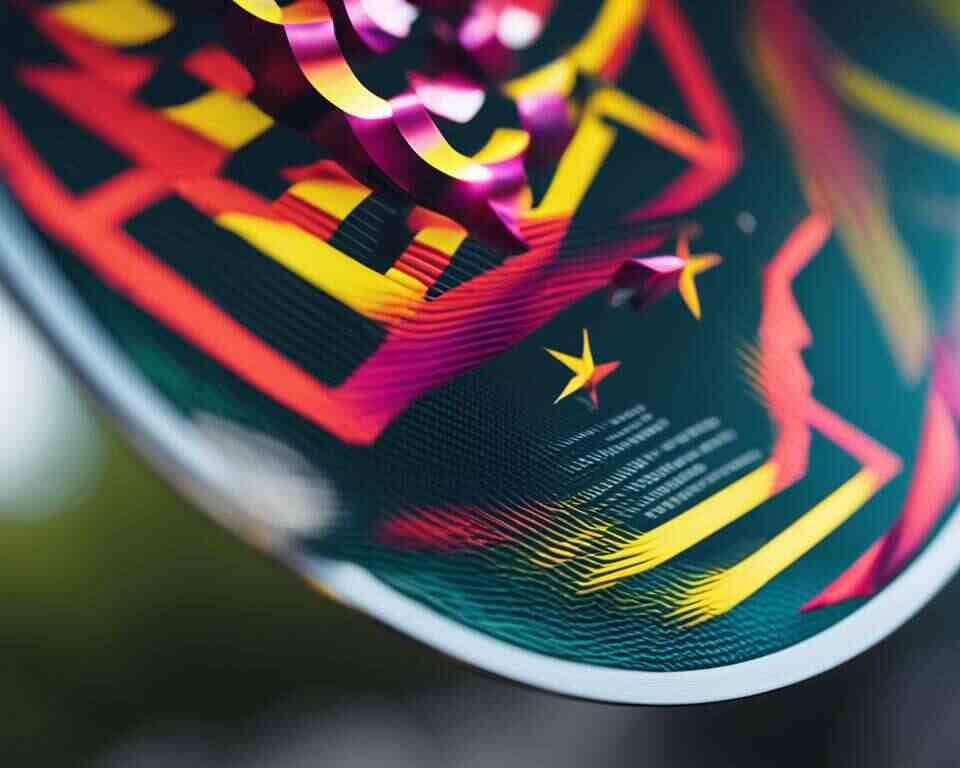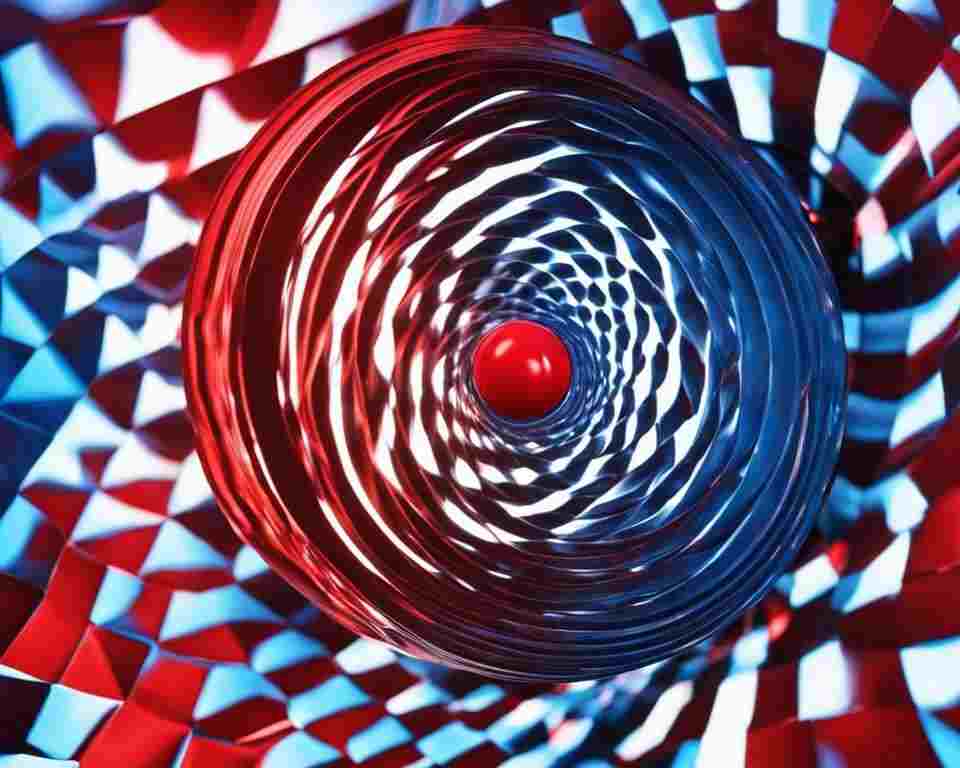Disc golf is a dynamic sport with its own unique terminology and concepts. One such term that often comes up in disc golf discussions is “understable.” But what does understable mean in the context of disc golf?
An understable disc refers to a disc that has a tendency to turn to the right during its flight, assuming a right-handed, backhand thrower. It is the opposite of overstable, which means the disc fades to the left. The concept of understability is crucial for disc golfers to grasp as it can greatly influence their throwing techniques and shot selection on the course.
Key Takeaways:
- An understable disc in disc golf tends to turn to the right during its flight.
- Understanding understability is essential for disc golfers to make informed decisions on the course.
- Understable discs are the opposite of overstable discs, which fade to the left.
- Understable discs are ideal for beginners, players with slower arm speeds, and certain shot shapes.
- Exploring different understable discs can help players find the right disc for their throwing style and course conditions.

What Does Understable Mean in Disc Golf?
In disc golf, the term “understable” refers to a disc’s tendency to turn to the right (for right-handed backhand throws) or to the left (for left-handed backhand throws) during its flight. An understable disc is designed to be more responsive to the release angle and the power exerted by the player.
Key characteristics of an understable disc include:
- Turn: Understable discs typically have a negative turn rating in their flight characteristics. This indicates that they are more likely to turn in the direction opposite to their spin. For example, a disc with a -2 turn rating is likely to turn more than a disc with a -1 turn rating.
- Low Fade: Understable discs often have a low fade rating. Fade is a measure of a disc’s tendency to hook left at the end of its flight for right-handed backhand throws (or right for left-handed backhand throws). A low fade means the disc is less likely to make a hard left turn at the end of the flight.
- Greater Glide: Understable discs tend to have a higher glide rating. Glide is a measure of the disc’s ability to maintain lift during flight, and a higher glide rating suggests that the disc will stay in the air longer.
Players use understable discs when they want a disc to turn to the right (for right-handed backhand throws) early in the flight or to navigate around obstacles. Beginners and players with slower arm speeds may also find understable discs easier to control.
Understanding the Flight Ratings
In disc golf, the flight characteristics of a disc are typically represented by four numbers: Speed, Glide, Turn, and Fade. For an understable disc, the Turn rating will be a negative number, indicating that the disc has a natural tendency to turn to the right. The Speed and Glide ratings will generally be lower, indicating that the disc is designed for slower, controlled flights. The Fade rating will be minimal, meaning that the disc will not have a significant fade at the end of its flight.
These flight ratings are important for disc golfers to consider when selecting discs for different types of shots and course conditions. An understable disc with a higher Turn rating will have a more pronounced right-turning flight, while one with a lower Turn rating will exhibit a subtle fade. The Speed rating determines how fast the disc needs to be thrown to achieve its optimal flight, while the Glide rating indicates the disc’s ability to maintain lift and carry through the air.
When comparing the flight ratings of understable discs, it’s essential to evaluate how they complement your throwing style and desired shot shapes. Discs with higher Speed and Glide ratings may offer more distance potential but require greater throwing power to achieve their intended flight. On the other hand, discs with lower Speed and Glide ratings may be easier to control and manipulate for certain shot types.
| Flight Rating | Description |
|---|---|
| Speed | Indicates the disc’s required throwing velocity for optimal flight. |
| Glide | Reflects the disc’s ability to maintain lift and carry through the air. |
| Turn | Defines the disc’s natural tendency to turn to the right (for right-handed, backhand throwers). |
| Fade | Represents the disc’s tendency to fade, or curve, at the end of its flight. |
In conclusion, understanding the flight ratings of understable discs is crucial for disc golfers looking to optimize their throws and shot selection. By considering the Speed, Glide, Turn, and Fade ratings, players can choose discs that suit their throwing style, desired shot shapes, and course conditions. Experimentation and practice with different discs will help players develop a deeper understanding of how flight ratings impact disc performance and enhance their overall disc golf experience.

Choosing the Right Disc
When it comes to disc golf, choosing the right disc is essential for achieving optimal performance on the course. Understanding the differences between understable and overstable discs is crucial in making informed decisions that align with your playing style and throwing technique.
Understable discs, as mentioned in the previous section, have a tendency to turn to the right during flight. They are ideal for beginners or players with slower arm speeds, as they require less power to achieve desired flight lines. These discs are also useful for executing shots that require an anhyzer or turnover line. On the other hand, overstable discs are better suited for players with faster arm speeds or when dealing with windy conditions. They provide a reliable fade to the left, making them suitable for shots that require a strong finish.
When selecting an understable disc, it’s important to consider the disc’s flight rating. As mentioned earlier, the Turn rating will be a negative number, indicating the disc’s natural tendency to turn to the right. Additionally, the Speed and Glide ratings will generally be lower, indicating that the disc is designed for slower, controlled flights. The Fade rating, on the other hand, will be minimal, meaning that the disc will not have a significant fade at the end of its flight.
Exploring Flight Paths
The flight path of an understable disc can vary depending on various factors, including the thrower’s technique, the speed and angle of the throw, and the disc’s specific flight characteristics. Generally, understable discs will start out flying relatively straight but will gradually turn to the right (for a right-handed, backhand thrower). This gradual turn makes understable discs ideal for shots that require a turnover or anhyzer line.
To understand the flight path of an understable disc, imagine a disc being thrown in a flat horizontal line. As the disc speeds up during the initial part of the flight, it creates lift on the top side of the disc. This lift, combined with the understable nature of the disc, causes it to turn to the right. The amount of turn will depend on the disc’s specific flight ratings, such as the negative turn rating.
It’s important for disc golfers to practice and develop consistency in their throws to accurately control and shape the flight path of understable discs. By adjusting the release angle and throw speed, players can manipulate the flight path of an understable disc to achieve a desired shot shape and navigate around obstacles on the course.
Flight Path Adjustments
- Increasing the throw speed can result in a more pronounced turn to the right, allowing players to execute shots that require a sharper angle.
- Decreasing the throw speed can minimize the turn and result in a straighter flight path.
- Altering the release angle can further shape the flight path. Releasing the disc with a slight hyzer angle (tilted to the left for a right-handed thrower) can counteract the natural turn of an understable disc, resulting in a straighter flight or even a subtle fade to the left.
Disc golfers should experiment with different combinations of speed, release angles, and disc selection to determine the flight path that best suits their playing style and shot needs on the course.

Examining Disc Dimensions
Understanding the dimensions of an understable disc in disc golf is crucial for players looking to optimize their throwing techniques and shot selection. The dimensions of a disc can greatly impact its flight characteristics, grip, and overall performance on the course. When it comes to understable discs, there are a few key dimensions to consider.
Grip and Comfort
Understable discs typically have a slightly smaller diameter compared to other types of discs, ranging from around 21 to 22 centimeters. This smaller diameter allows for a comfortable grip, especially for players with smaller hands. Additionally, the rim depth and rim width of understable discs are usually shallow, further enhancing the grip and overall feel of the disc.
Flight Performance
The dimensions of an understable disc contribute to its flight characteristics. The smaller diameter and shallow rim of these discs often result in a more controllable and finesse-oriented flight. These discs tend to excel at slower, controlled flights and can be maneuvered easily through narrow fairways or tight gaps on the course.
| Disc Dimension | Understable Disc Range |
|---|---|
| Diameter | Approximately 21-22 centimeters |
| Rim Depth | Shallow |
| Rim Width | Varies depending on model |
By understanding the dimensions of an understable disc, players can make more informed decisions when selecting discs for their bag. It’s important to experiment with different discs and find the ones that feel comfortable in your hand and meet your specific needs on the course. Whether you’re a beginner or an experienced player, the dimensions of an understable disc play a significant role in maximizing your disc golf performance.

Understanding Skill Level Suitability
When it comes to disc golf, understanding the meaning of “understable” is crucial for players of all skill levels. Understable discs offer unique flight characteristics that can greatly impact your gameplay. Let’s take a closer look at what understable means and how it can affect your disc selection and throwing techniques.
Disc golfers often wonder if understable discs are suitable for their skill level. The truth is, understable discs can benefit players of all experience levels. For beginners, these discs can be a valuable tool in learning and developing throwing techniques. Understable discs have a natural tendency to turn to the right (for a right-handed, backhand thrower), making it easier for beginners to achieve desired flight lines with less power. As players progress and improve their arm speed and throwing power, they can continue to use understable discs to execute specific shot shapes and work on their control and finesse.
Even experienced disc golfers can benefit from having understable discs in their bag. These discs excel in certain shot types, such as straight shots, turnovers, and anhyzer shots. The ability to shape shots and navigate around obstacles on the course is invaluable. Additionally, understable discs can be useful in certain course conditions, allowing players to adapt to different wind conditions and achieve the desired flight path.
Ultimately, the skill level suitability of understable discs depends on an individual player’s throwing style, preferences, and the specific course conditions they encounter. It’s important to experiment with different discs and find the ones that feel comfortable in your hand and meet your specific needs on the course. Having a mix of understable and overstable discs in your bag can provide you with a versatile arsenal to tackle any disc golf challenge.
Table: Comparing Disc Flight Ratings
| Disc Model | Speed | Glide | Turn | Fade |
|---|---|---|---|---|
| MVP Signal | 6 | 5 | -3 | 1 |
| Thought Space Mantra | 9 | 5 | -2 | 1 |
| Kastaplast Falk | 9 | 6 | -2 | 1 |
| Axiom Crave | 6 | 5 | -1 | 1 |
Exploring Shot Types
When it comes to disc golf, understanding the flight characteristics of an understable disc is crucial in mastering different shot types. Understable discs offer unique flight paths that can be utilized by disc golfers to achieve specific shot shapes and navigate around obstacles on the course. The flight ratings of an understable disc, particularly the turn and glide, play a significant role in determining the ideal use for different shot types.
An understable disc’s flight path typically begins with a relatively straight trajectory but gradually turns to the right (for a right-handed, backhand thrower). This flight pattern makes understable discs ideal for executing turnovers and anhyzer shots. Disc golfers can use these discs to shape their shots, maneuver through tight fairways, and avoid obstacles effectively.
The turn and glide ratings of an understable disc indicate its ability to turn to the right and maintain loft during its flight. Disc golfers can capitalize on these flight characteristics to unleash a variety of shot types, including straight shots with subtle turnovers, controlled hyzer flips, and sweeping anhyzer lines. By carefully selecting the right understable disc and adjusting their technique, disc golfers can achieve the desired flight path and shot outcome.
| Shot Type | Understable Disc Flight Characteristics |
|---|---|
| Straight Shots | Minimal fade, gradual turn to the right |
| Turnovers | Significant turn to the right, maintaining loft |
| Anhyzer Shots | Sweeping turn to the right, holding the desired flight path |
Disc golfers should experiment with different understable discs and practice various shot types to develop proficiency in utilizing these discs effectively. Understanding how the flight ratings of an understable disc translate into specific shot shapes is key to expanding one’s disc golf skills and navigating the course with finesse.
Comparing Similar Discs
When it comes to selecting the right understable disc for your disc golf game, there are several options available in the market. Let’s take a closer look at some similar discs that offer understable flight characteristics.
MVP Signal
The MVP Signal is a versatile disc that caters to players of all skill levels. With a speed rating of 6, glide rating of 5, turn rating of -3, and fade rating of 1, this disc is designed for controlled flights and offers a predictable turn to the right. Its flight profile makes it an excellent option for those looking for an easy-to-control disc that can be used for a variety of shots.
Thought Space Mantra
The Thought Space Mantra is another disc known for its understable flight characteristics. With a speed rating of 11, glide rating of 6, turn rating of -3, and fade rating of 1, this disc provides players with long, straight flights and predictable turnovers. It is an ideal choice for players who want to add distance to their game and execute precise shot shapes.
Kastaplast Falk
The Kastaplast Falk is a popular understable driver that offers excellent glide and control. With a speed rating of 9, glide rating of 6, turn rating of -2, and fade rating of 1, this disc provides players with easy distance and reliable turnovers. Its flight characteristics make it a favorite among players of all skill levels.
These discs, along with many others, provide disc golfers with a range of options when it comes to selecting an understable disc. It’s important to consider factors such as speed, glide, turn, and fade ratings, as well as personal preferences and throwing style, when making a decision. Ultimately, finding the right understable disc can greatly enhance your game and allow you to execute a variety of shots with precision and control.

The Versatility of the Signal Disc
The MVP Signal is a highly versatile disc that provides a range of flight options for disc golfers. Its understable flight profile makes it suitable for both beginners and experienced players. Beginners can benefit from its ease of control and forgiving nature, while experienced players can leverage its flight characteristics for specific shot shapes and finesse shots. The Signal’s versatility extends to its use in different shot types, including straight shots, anhyzers, and rollers. However, it’s important to note that the Signal may not perform well in high wind conditions or for shots requiring a fade finish. Disc golfers should consider the Signal as one of many options in their disc selection to cover various shot needs and course conditions.
When selecting discs for their bag, disc golfers should consider the specific flight characteristics that the Signal offers. Its speed rating of 6 signifies a disc that is controllable and suitable for a variety of throwing speeds. The glide rating of 5 indicates that the disc maintains its distance and carry throughout the flight. The turn rating of -3 showcases the Signal’s natural tendency to turn to the right, enabling players to navigate around obstacles and shape their shots with ease. The minimal fade rating of 1 means that the disc finishes its flight with minimal leftward movement.
To highlight the versatility of the Signal disc, here is a comparison table of similar discs with their flight ratings:
| Disc | Speed | Glide | Turn | Fade |
|---|---|---|---|---|
| MVP Signal | 6 | 5 | -3 | 1 |
| Thought Space Mantra | 7 | 5 | -2 | 1 |
| Kastaplast Falk | 9 | 6 | -2 | 2 |
| Axiom Crave | 6 | 5 | -1.5 | 1 |
As shown in the table, the Signal falls within the lower end of the speed spectrum, making it suitable for players with a variety of throwing speeds. Its unique flight ratings allow for controlled and precise shots. While the other discs listed offer similar flight characteristics, disc golfers should consider the specific features and feel of each disc to find the one that best suits their preferences and playing style. The Signal should be seen as a versatile option among many others in disc selection, providing disc golfers with flexibility and a range of shot options on the course.
Conclusion
Understanding what understable means in disc golf is crucial for informed decision-making about disc selection and throwing techniques. Understable discs possess unique flight characteristics that can benefit players of all skill levels. By incorporating understable discs into their game, players can achieve specific shot shapes, navigate obstacles, and refine control and finesse on the disc golf course.
Experimentation with different discs and practice of various shot types are key to developing proficiency in using understable discs effectively. Whether you’re a beginner or an experienced player, understable discs can prove invaluable additions to your disc golf bag.
Disc golf understable discs are designed to turn to the right during flight, making them ideal for shots that require turnovers or anhyzer lines. The flight ratings of understable discs, such as the turn and glide, play a significant role in determining their optimal use for different shot types.
Mastering the art of throwing understable discs not only expands your range of shot options but also enhances your overall performance on the disc golf course. So next time you hit the course, grab an understable disc and unlock new possibilities in your game!
FAQ
What does understable mean in disc golf?
In disc golf, understable refers to the flight characteristics of a disc. An understable disc tends to turn to the right (for a right-handed, backhand thrower) during its flight, as opposed to overstable discs that fade to the left.
How are understable discs represented in flight ratings?
Understable discs typically have a negative Turn rating, indicating their natural tendency to turn to the right. The Speed and Glide ratings are generally lower, indicating slower, controlled flights. The Fade rating is minimal, meaning the disc doesn’t have a significant fade at the end of its flight.
When should I choose an understable disc for my disc golf bag?
Understable discs are ideal for beginners or players with slower arm speeds, as they require less power to achieve desired flight lines. They are also useful for certain shot shapes, such as anhyzer shots or turnovers. Overstable discs are better suited for players with faster arm speeds or in windy conditions.
What is the flight path of an understable disc?
Understable discs generally start out flying relatively straight and gradually turn to the right for right-handed, backhand throwers. This flight path makes them ideal for shots that require a turnover or anhyzer line.
What are the dimensions of an understable disc?
Understable discs typically have a slightly smaller diameter (around 21-22 centimeters) and shallow rim depth and width. These dimensions contribute to their flight characteristics and the disc’s performance in different throwing situations.
Are understable discs suitable for all skill levels?
Yes, understable discs are suitable for a wide range of skill levels. Beginners can benefit from their forgiving nature and ease of control, while experienced players can leverage their flight characteristics for specific shot shapes and finesse shots.
What shot types are understable discs used for?
Understable discs excel in straight shots, turnovers, and anhyzer shots. Their natural tendency to turn to the right allows players to shape their shots and navigate around obstacles on the course.
What are some similar discs to the MVP Signal?
Similar discs to the MVP Signal include the Thought Space Mantra, Kastaplast Falk, and Axiom Crave. Each disc has its own unique flight characteristics and suitability for different throwing styles and skill levels.
How versatile is the MVP Signal disc?
The MVP Signal is a highly versatile disc suitable for both beginners and experienced players. Its understable flight profile provides a range of flight options, making it useful for straight shots, anhyzers, and rollers.
What is the importance of understanding understable in disc golf?
Understanding understable in disc golf helps players make informed decisions about their disc selection and throwing techniques. It allows players to achieve specific shot shapes, navigate around obstacles, and fine-tune their control and finesse on the disc golf course.


